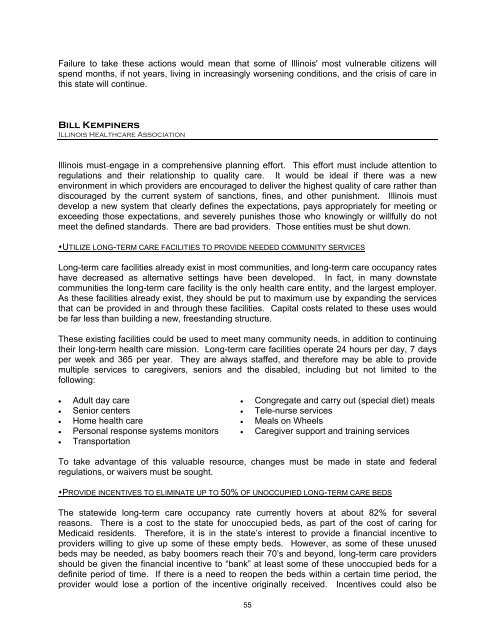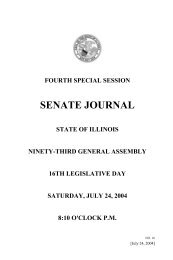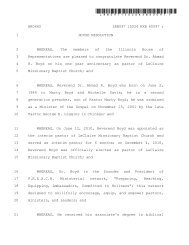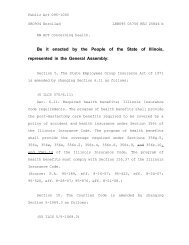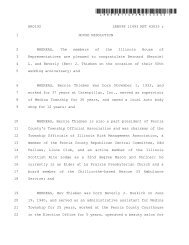Long-Term Care - Illinois General Assembly
Long-Term Care - Illinois General Assembly
Long-Term Care - Illinois General Assembly
You also want an ePaper? Increase the reach of your titles
YUMPU automatically turns print PDFs into web optimized ePapers that Google loves.
Failure to take these actions would mean that some of <strong>Illinois</strong>' most vulnerable citizens will<br />
spend months, if not years, living in increasingly worsening conditions, and the crisis of care in<br />
this state will continue.<br />
Bill Kempiners<br />
<strong>Illinois</strong> Healthcare Association<br />
<strong>Illinois</strong> must engage in a comprehensive planning effort. This effort must include attention to<br />
regulations and their relationship to quality care. It would be ideal if there was a new<br />
environment in which providers are encouraged to deliver the highest quality of care rather than<br />
discouraged by the current system of sanctions, fines, and other punishment. <strong>Illinois</strong> must<br />
develop a new system that clearly defines the expectations, pays appropriately for meeting or<br />
exceeding those expectations, and severely punishes those who knowingly or willfully do not<br />
meet the defined standards. There are bad providers. Those entities must be shut down.<br />
UTILIZE LONG-TERM CARE FACILITIES TO PROVIDE NEEDED COMMUNITY SERVICES<br />
<strong>Long</strong>-term care facilities already exist in most communities, and long-term care occupancy rates<br />
have decreased as alternative settings have been developed. In fact, in many downstate<br />
communities the long-term care facility is the only health care entity, and the largest employer.<br />
As these facilities already exist, they should be put to maximum use by expanding the services<br />
that can be provided in and through these facilities. Capital costs related to these uses would<br />
be far less than building a new, freestanding structure.<br />
These existing facilities could be used to meet many community needs, in addition to continuing<br />
their long-term health care mission. <strong>Long</strong>-term care facilities operate 24 hours per day, 7 days<br />
per week and 365 per year. They are always staffed, and therefore may be able to provide<br />
multiple services to caregivers, seniors and the disabled, including but not limited to the<br />
following:<br />
• Adult day care<br />
• Senior centers<br />
• Home health care<br />
• Personal response systems monitors<br />
• Transportation<br />
• Congregate and carry out (special diet) meals<br />
• Tele-nurse services<br />
• Meals on Wheels<br />
• <strong>Care</strong>giver support and training services<br />
To take advantage of this valuable resource, changes must be made in state and federal<br />
regulations, or waivers must be sought.<br />
PROVIDE INCENTIVES TO ELIMINATE UP TO 50% OF UNOCCUPIED LONG-TERM CARE BEDS<br />
The statewide long-term care occupancy rate currently hovers at about 82% for several<br />
reasons. There is a cost to the state for unoccupied beds, as part of the cost of caring for<br />
Medicaid residents. Therefore, it is in the state’s interest to provide a financial incentive to<br />
providers willing to give up some of these empty beds. However, as some of these unused<br />
beds may be needed, as baby boomers reach their 70’s and beyond, long-term care providers<br />
should be given the financial incentive to “bank” at least some of these unoccupied beds for a<br />
definite period of time. If there is a need to reopen the beds within a certain time period, the<br />
provider would lose a portion of the incentive originally received. Incentives could also be<br />
55


